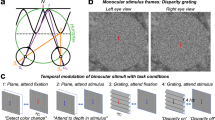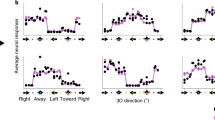Abstract
WHEN a human observer views a tridimensionally ordered scene, each of his eyes receives a slightly different perspective view of the scene. Differences in tridimensional location are coded on to the retinae as differences in bidimensional position, that is to say, as retinal disparities. As is well known1, retinal disparity alone produces compelling perceived spatial separation. The way in which the nervous system decodes retinal disparity into perceived spatial separation is somewhat mysterious, since retinal disparity alone does not specify whether an object is nearer or farther than a fixated object, but merely that they are not in the same plane. (Disparities are geometrically ambiguous. For them to become unambiguous, additional information is required. Different authors have involved different sources of information, none of which is wholly satisfactory: see, for example, ref. 2).) The nervous system obviously can distinguish these two situations but the way in which it does this is not clear. Hering3 solved the problem by giving each point on the two retinae a specific depth-value. On this model all points on the nasal hemiretinae of each eye have positive depth-values, so that any point imaged there will be seen as further than the fixation point, while points on the temporal hemiretinae have negative depth-values, so that points imaged there will be seen as nearer than the fixation point. This simple and elegant solution has never gained wide acceptance, largely because Hering never specified any mechanism which could add depth-values to inputs. The specification of a mechanism to do that is as great a problem as the specification of a mechanism to decode retinal disparity into perceived spatial separation. It is no wonder that the majority of investigators felt that Hering had solved one mystery by another mystery.
This is a preview of subscription content, access via your institution
Access options
Subscribe to this journal
Receive 51 print issues and online access
$199.00 per year
only $3.90 per issue
Buy this article
- Purchase on Springer Link
- Instant access to full article PDF
Prices may be subject to local taxes which are calculated during checkout
Similar content being viewed by others
References
Wheatstone, C., Phil. Trans., 1, 371 (1838).
Bower, T., Goldsmith, W., and Hochberg, J. E., Percept. Mot. Skills, 14, 385 (1964).
Hering, E., Zur Lehre vom Ortsinne der Netzhaut (Engelmann, Leipzig, 1864).
Schön, W., Graefe's Archiv für Ophthalmologie, 20–22, 24 (1874–76, 1878).
See, for example, Rains, J., Vision Res., 3, 239 (1963). Bower, T., and Haley, L., Psychon. Sci., 1, 184 (1964).
Kohler, I., Psych. Issues, 3 (4) (1964).
Stumpf, C., Ueber den psychologischen Ursprung der Raumvorstellung (Berlin, 1873).
von Helmholtz, H., Physiol. Optics (trans. Southall) (Opt. Soc. Amer., 1925).
Tschermak, A., and Kiribuchi, M., Archiv für die gesamte Physiol. (Pflueger), 81, 328 (1900).
Katz, M., and Schwarz, I., J. Opt. Soc. Amer., 45, 523 (1955).
For example, Weisstein, N., and Haber, R. N., Psychon. Sci., 2, 75 (1965).
von Békésy, G., Ann. Otol. Rhinol. Laryngol., 74, 445 (1965).
Author information
Authors and Affiliations
Rights and permissions
About this article
Cite this article
BOWER, T. A Local Sign for Depth. Nature 210, 1081–1082 (1966). https://doi.org/10.1038/2101081a0
Issue Date:
DOI: https://doi.org/10.1038/2101081a0
Comments
By submitting a comment you agree to abide by our Terms and Community Guidelines. If you find something abusive or that does not comply with our terms or guidelines please flag it as inappropriate.



